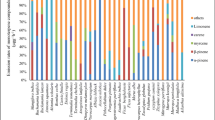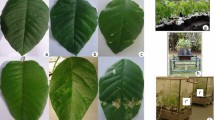Abstract
In natural environment with ambient air, ginkgo trees emitted volatile organic compounds 0.18 μg g−1 h−1 in July, and 0.92 μg g−1 h−1 in September. Isoprene and limonene were the most abundant detected compounds. In September, α-pinene accounted for 22.5% of the total. Elevated CO2 concentration in OTCs increased isoprene emission significantly in July (p < 0.05) and September (p < 0.05), while the total monoterpenes emission was enhanced in July and decreased in September by elevated CO2. Exposed to elevated O3 increased the isoprene and monoterpenes emissions in July and September, and the total volatile organic compounds emission rates were 0.48 μg g−1 h−1 (in July) and 2.24 μg g−1 h−1 (in September), respectively. The combination of elevated CO2 and O3 did not have any effect on biogenic volatile organic compounds emissions, except increases of isoprene and Δ3-carene in September.

Similar content being viewed by others
References
Calfapietra C, Wiberley AE, Falbel TG, Linskey AR, Mugnozza GS, Karnosky DF, Loreto F, Sharkey TD (2007) Isoprene synthase expression and protein levels are reduced under elevated O3 but not under elevated CO2 (FACE) in field-grown aspen trees. Plant Cell Environ 30:654–661. doi:10.1111/j.1365-3040.2007.01646.x
Centritto M, Liu SR, Loreto F (2005) Biogenic emission of volatile organic compounds by urban forests. Chin Forensic Sci Tech 4:20–26
Constable JVH, Litvak ME, Greenberg JP, Monson RK (1999) Monoterpene emission from coniferous trees in response to elevated CO2 concentration and climate warming. Global Change Biol 5:255–267
IPCC (2001) Third assessment report – climate change 2001: the scientific basis. Cambridge University Press, Cambridge
Llusia J, Penuelas J, Gimeno BS (2002) Seasonal and species-specific response of VOC emissions by Mediterranean woody plant to elevated ozone concentrations. Atmos Environ 36:3931–3938. doi:10.1016/S1352-2310(02)00321-7
Loreto F, Fischbach RJ, Schnitzler JP, Ciccioli P, Brancaleoni E, Calfapietra C, Seufert G (2001) Monoterpene emission and monoterepene synthase activities in the Mediterranean evergreen oak Quercus ilex L. grown at elevated CO2 concentrations. Global Change Biol 7:709–717. doi:10.1046/j.1354-1013.2001.00442.x
Loreto F, Velikova V (2001) Isoprene produced by leaves protects the photosynthetic apparatus against ozone damage, quenches ozone products, and reduces lipid peroxidation of cellular membranes. New Phytol 127:1781–1787
Loreto F, Pinelli P, Manes F, Kollist H (2004) Impact of ozone on monoterpene emissions and evidence for an isoprene-like antioxidant action of monoterpenes emitted by Quercus ilex leaves. Tree Physiol 24:361–367
Penuelas J, Llusia J (2002) Linking photorespiration, monoterpenes and thermotolerance in Quercus. New Phytol 155:227–237. doi:10.1046/j.1469-8137.2002.00457.x
Rosenstiel TN, Potosnak MJ, Griffin KL, Fall R, Monson RK (2003) Increased CO2 uncouples growth from isoprene emission in an agriforest ecosystem. Nature 421:256–259. doi:10.1038/nature01312
Sallas L, Kainulainen P, Utriainen J, Holopainen T, Holopainen JK (2001) The influence of elevated O3 and CO2 concentrations on secondary metabolites of Scots pine seedlings. Global Change Biol 7:303–311. doi:10.1046/j.1365-2486.2001.00408.x
Velikova V, Pinelli P, Pasqualini S, Reale L, Ferranti F, Loreto F (2005a) Isoprene decreases the concentration of nitric oxide in leaves exposed to elevated ozone. New Phytol 166:419–426. doi:10.1111/j.1469-8137.2005.01409.x
Velikova V, Tsonko T, Pinelli P, Alessio GA, Loreto F (2005b) Localized ozone fumigation system for studying ozone effects on photosynthesis, respiration, electron transport rate and isoprene emission in field-grown Mediterranean oak species. Tree Physiol 25:1523–1532
Vuorinen T, Nerg A-M, Vapaavuori E, Holopainen JK (2005) Emission of volatile organic compounds from two silver birch (Betula pendula Roth) clones grown under ambient and elevated CO2 and different O3 concentrations. Atmos Environ 39:1185–1197. doi:10.1016/j.atmosenv.2004.09.077
Acknowledgments
This research was supported by the 2nd International Conference on Pollution Ecology. The authors wish to express their appreciation to Prof. Dali Tao, Institute of Applied Ecology, Chinese Academy of Sciences, Shenyang, China, for his helpful suggestions and constructive review for this manuscript.
Author information
Authors and Affiliations
Corresponding author
Additional information
Foundation item: The National Natural Science Foundation of China (No. 90411019).
Rights and permissions
About this article
Cite this article
Li, D., Chen, Y., Shi, Y. et al. Impact of Elevated CO2 and O3 Concentrations on Biogenic Volatile Organic Compounds Emissions from Ginkgo biloba . Bull Environ Contam Toxicol 82, 473–477 (2009). https://doi.org/10.1007/s00128-008-9590-7
Received:
Accepted:
Published:
Issue Date:
DOI: https://doi.org/10.1007/s00128-008-9590-7




